“What am I in the eyes of most people – a non-entity, an eccentric, or an unpleasant person – somebody, who has no position in society and will never have; in short, the lowest of the low. All right, then – even if that were absolutely true, then I should one day like to show by my work what such an eccentric, such a nobody, has in his heart.”
— Vincent van Gogh
The Singularity
Proposed Conditions for Collective Behavioral Intelligence
Assertions:
- The information retrieval network (I.R.N.) dynamically adapts its frame-systems at a frequency f = (1/dt), modulated by the perceived situational dynamics at each instant (dt). This enables the I.R.N. to reflect subtle changes in the collective experience and memory.
- At each instant (dt), each individual element makes a decentralized choice to address its own locally perceived situation, suggesting maximum feasible decision autonomy.
- Assuming swarm growth rate constancy over a period, individual choices must correspond to Nash equilibria in proportion to swarm growth.
Assumptions:
(i) Swarm growth rate is constant over a defined period.
(ii) Initially, only elemental strategic interactions are considered, ignoring internal cognitive structures, proving assertions 2 and 3 first.
The proof is derived using the n-element miniature swarm model and is executed utilizing the mass action interpretation of Nash equilibrium. Game theoretic arguments presented in Merger-3 (specifically games dG and N.dG) and population dynamics analyzed in Merger-4 are leveraged to carry out the proof. Before proceeding next, the reader is encouraged to review Proposition 2 detailed on pages 8-10 of Weibull (1994) for pertinent background information.
Mass Action of the Mass Action Interpretation of Nash Equilibrium
See below for proof:
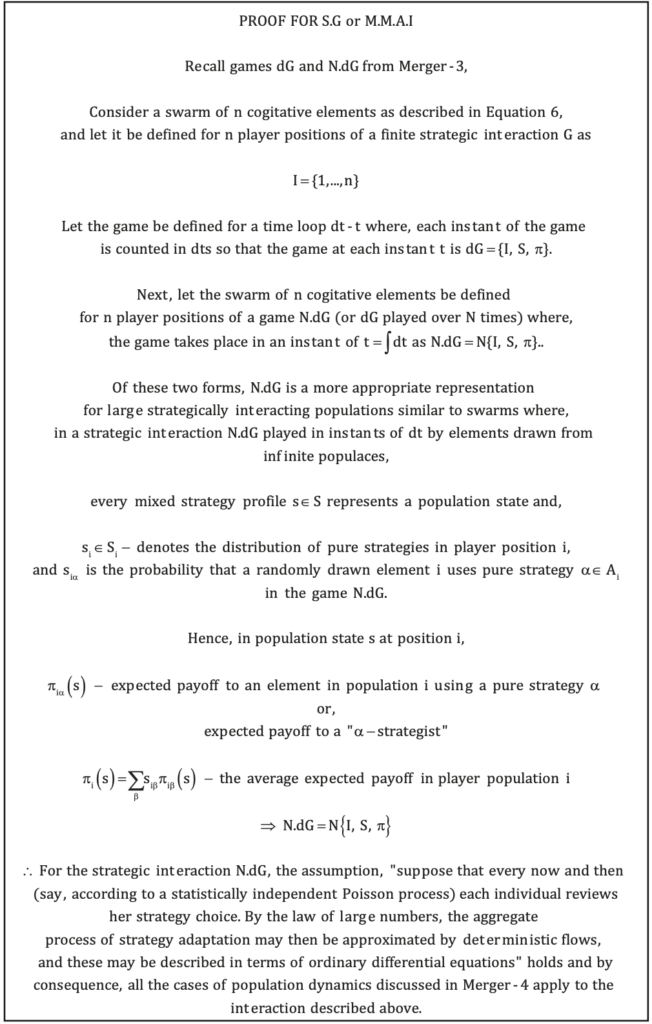
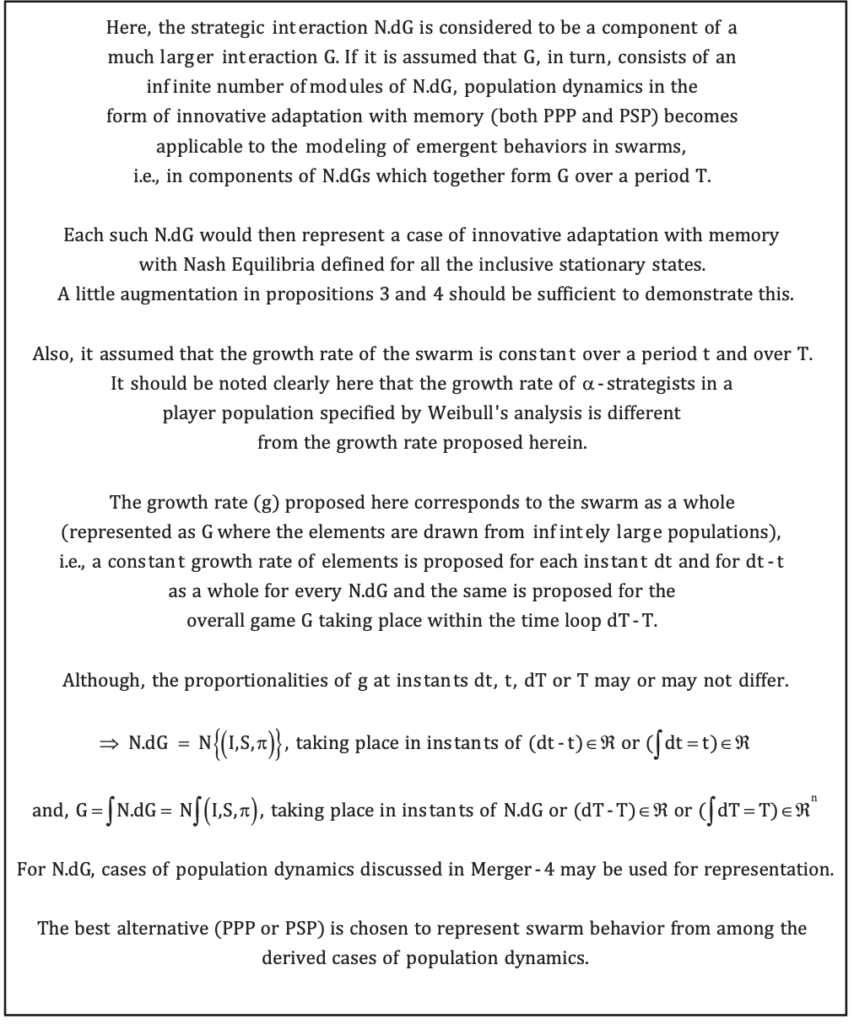
The previous section reviewed five cases of population dynamics. The proof developed thus far considers all facets of swarm behavior in a logically consistent manner. A time constraint is also enforced, which alters the inherent nature of the game-theoretic arguments presented in Merger-3. Consequently, new properties may be imposed on the examined cases of population dynamics, of which only two were deemed applicable to the current need: (1) Population-Payoff-Perception (PPP) and (2) Perceived Population Shares (PSP). Of these two properties, (1) Population-Payoff-Perception (PPP) is utilized to demonstrate that strategic equilibria exist in the form of Nash Equilibria in “large strategically interacting populations” modeled as swarms.
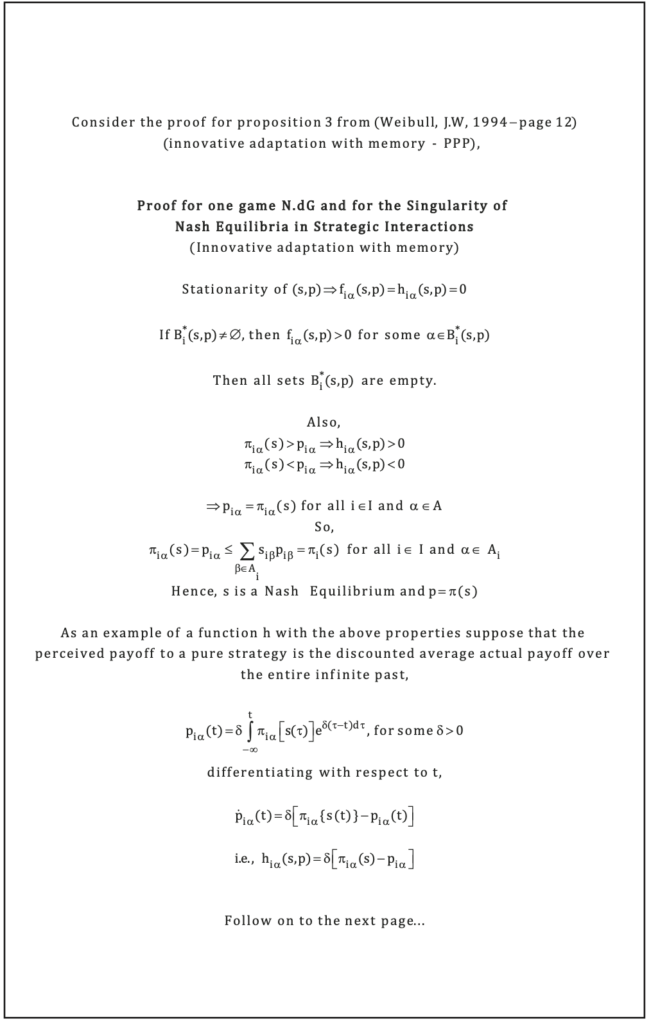
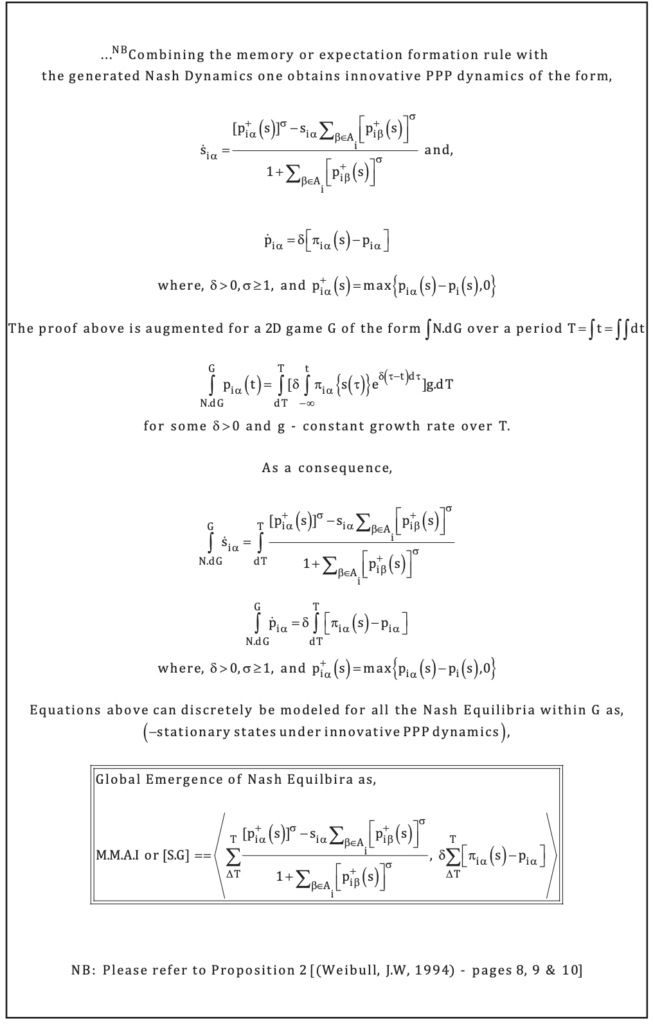
Function S.G demonstrates that a larger game G comprised of components of N.dG would contain subsets of Nash equilibria for all the N.dGs within the game. As exhibited in thought-simulation 13, each N.dG is enacted over its own perceived timeframe of ∫dt, while game G containing multiple N.dG modules is executed over a timeframe of ∫dT encompassing all ∫dts. This representation establishes that if game G with embedded N.dGs transpires at such a velocity that the resultant of the game persistently materializes in both the N.dGs and Gs across a broader terrain of observation (>>T), the essence of time becomes deceptive. As previously described:
“If the repetitive manifestation of emergence is perceived by an observer, the nature of time becomes deceptive and the transitory stages that induce the emergence become lost in an illusory coalescence of absence. This is analogous to a motion picture presenting geometric fractals.”
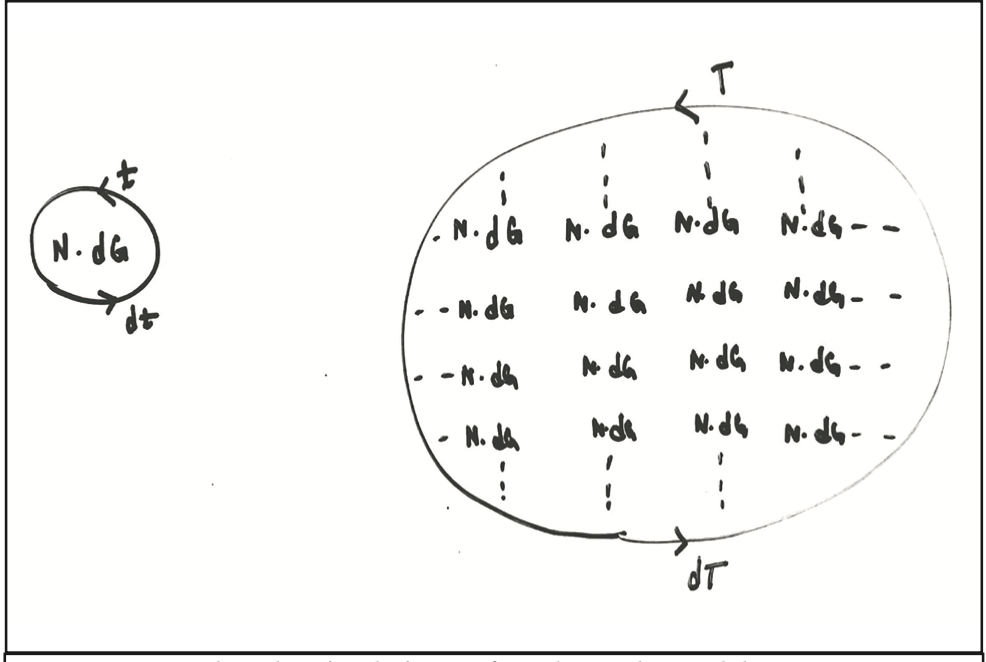
Incorporation of a steady growth rate ‘g’ into the phenomenon allows for regular influx of strategies from memory or from an innovative state space against the evolving dynamics of the game at every N.dG over period T. The proof outlined and augmented for Proposition 3 can be similarly developed for Proposition 4 (Weibull, 1994, p. 14). The internal operations detailed in Merger-1 and Merger-2 are considered intrinsic to the macroscopic elemental interactions modeled via game theory, i.e., if the theory of thinking constructed through Merger-2 is regarded as supplementary to the macroscopic elemental interaction represented as S.G, then by definition, all the emergent strategies corresponding to all inclusive states of Nash equilibria must themselves arise from proportional states of Nash equilibria at the I.R.N, analogous to condition 1 proposed for collective behavioral intelligence:
“The I.R.N changes frame-systems at a constant frequency f = (1/dt) based on the dynamics of the perceived situation at every instant dt.”
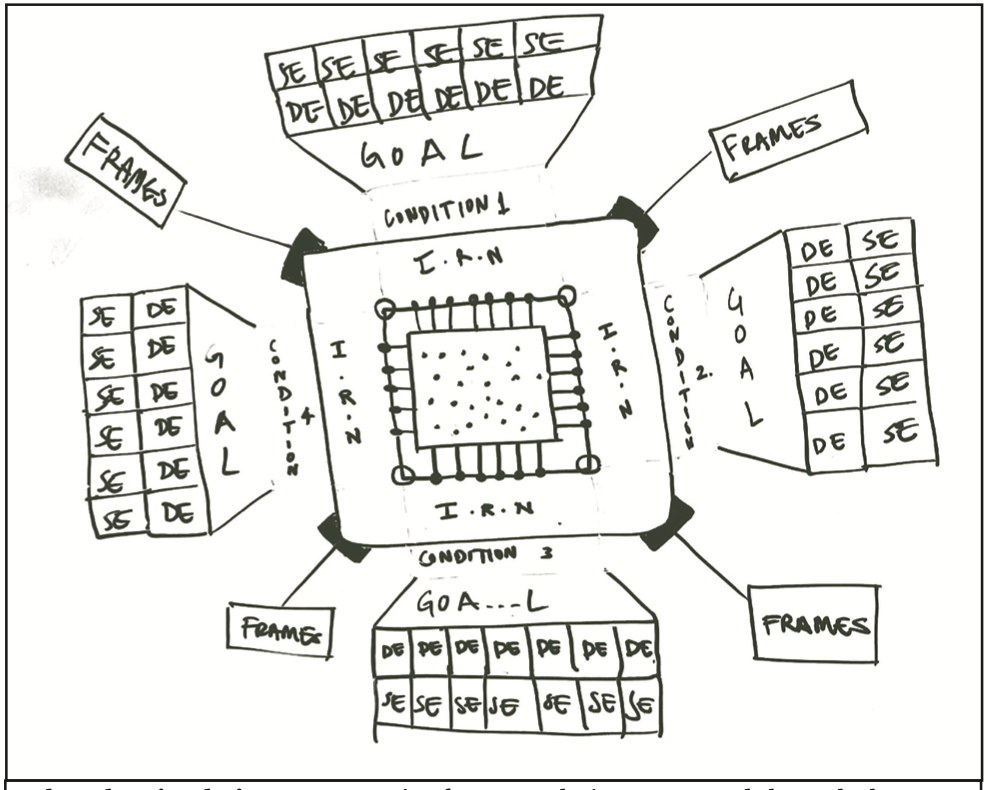
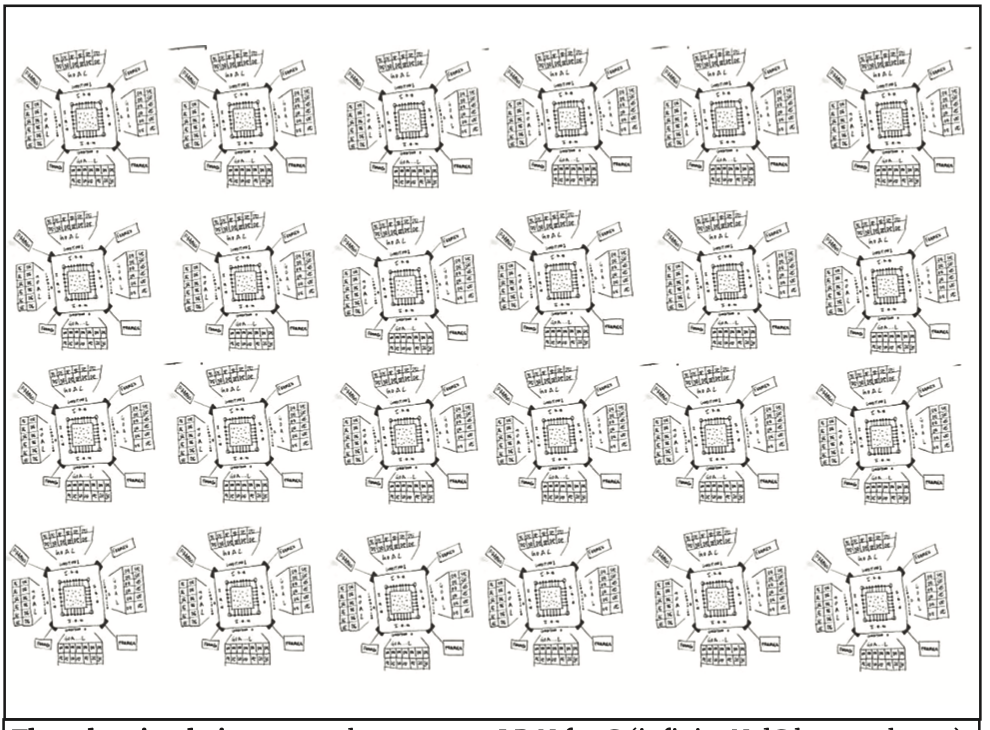
In thought-simulation 14, states of Nash equilibria (—•) are exhibited as arising from the internal structure of a swarm, and the internal composition of the population or swarm is illustrated using sets of frames, difference-engines, similarity-engines, and a collective I.R.N. In other words, at every instant dt, internal strategic decisions within the structure of each element in the swarm must lead to the original or ultimate choices of the elements constituting the Nash equilibria.
This means the internal strategies must be Nash equilibria proportional to the growth rate of the swarm at some unknown level of proportionality intrinsically retained within the swarm. The representation is expanded to multiple populations and their respective distribution of pure strategies in thought-simulation 15. Axiomatically, these emergent states of Nash equilibria must derive from a proportional set of equilibria at the I.R.N. In light of evolutionary game theory and its applicability to biological games, a robust mathematical correlation is established next under the presumption that all frames, their systems, their terminal assignments, and markers are themselves mathematical functions in the form of strategies.
The concept is analogous to the partitions in number theory. If modeled strategies replace numbers as states of Nash Equilibria resulting from multiple states of Nash Equilibria of lower proportionalities, a singular Nash equilibrium of relevant value is attained (see thought-simulation 17). For instance, consider p(5); the number of partitions of 5 is seven including 5, 4+1, 3+2, 3+1+1, 2+2+1, 2+1+1+1, 1+1+1+1+1. Now, if states of equilibria in strategic interactions supplant the numbers, then every emergent state of equilibrium must derive from equilibria of lower proportionalities (see thought-simulation 16).
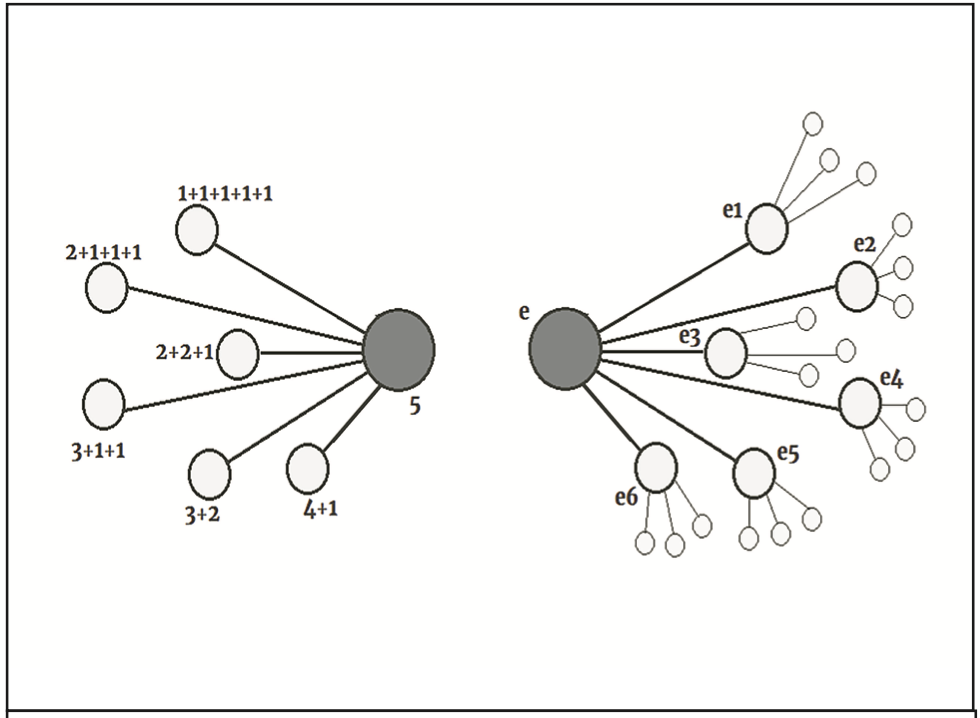
Recall the miniature swarm from Merger-1 where strategies were constructed by coalescing existing stratagems. Since it has been deduced from function S.G that inclusive states of Nash Equilibria exist as strategic equilibria at various levels of interaction in potentially infinite populations of cogitative elements (in PPP or PSP), it may be viable to model states of Nash Equilibria (e.g., e) from Nash Equilibria of lower proportionalities (e1, e2, e3, e4, e5 and e6) occurring at proportionally lower levels of strategic interaction as depicted in thought-simulation 16.
However, with equilibrium states the partitions would assume a fluid-like nature unlike the partitions of numbers, i.e., since states of equilibria are not as well-defined as numerals and because they may adopt any characteristic form in strategic interactions, they may represent simple equilibrium structures materializing from complex amalgamations as exhibited in thought-simulation 17.
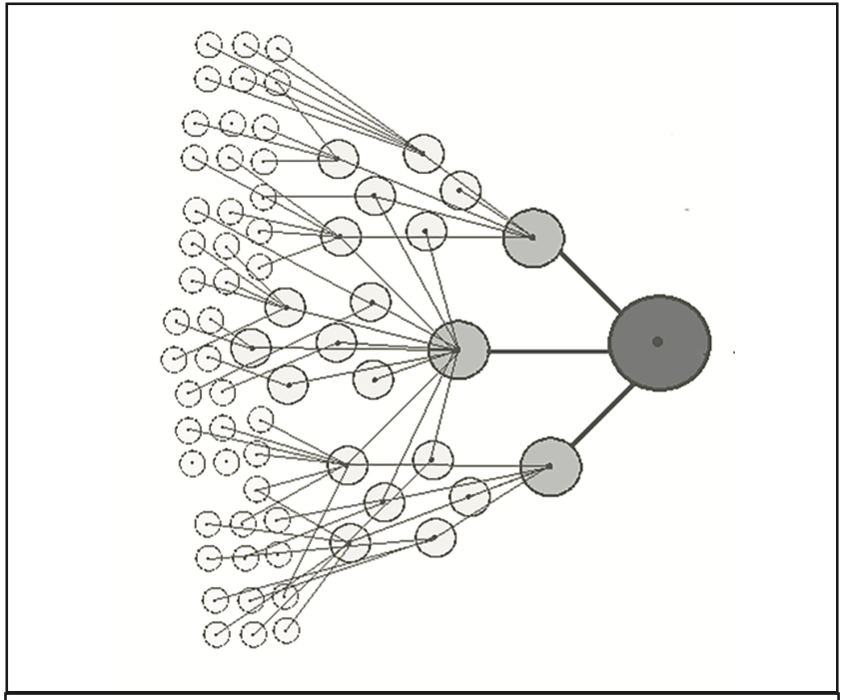
The selection of a method to model internal, proportional I.R.N states is at the discretion of the developer, but the underlying principle of strategic equilibria remains constant across any potential iteration of the concept. For further investigation, one may consult (Griffin, M, Ono, K & Rolen, L) and (Folsom, A, 2010), which provide insight into mathematical concepts such as partition functions, mock-theta functions, and exponential singularities that can be employed to model states of Nash equilibria. Notably, the strategies of individual elements in a collective set of Nash equilibria at the I.R.N. emerge from a collective set of Nash equilibria at every instant dt over a period ‘t’ with a constant growth rate of elements or with an innovative strategic influx. This results in a global emergence of Nash equilibria congruent with a game G of infinite N.dGs. The explanations provided thus far uncover the instinctive nature of strategy adaptation in games and describe population dynamics and emergent behaviors using neural prototypes and game theoretic arguments. Consequently, three assertions are made:
- If the analysis is expanded to infinite I.R.Ns from infinite populations, there must be a single emergence of Nash equilibria at each level of strategic interaction and one ultimate singularity of Nash equilibria with its pole at infinity.
- If the analysis is stretched over a spatial lattice, as done in (Killingback, T, Doebeli, M, 1996), and later inflated to a 3D-space, the collection of information embedded in the 3D-environment represents a wave.
- States of Nash equilibria correspond to the hypersensitive points in nature.
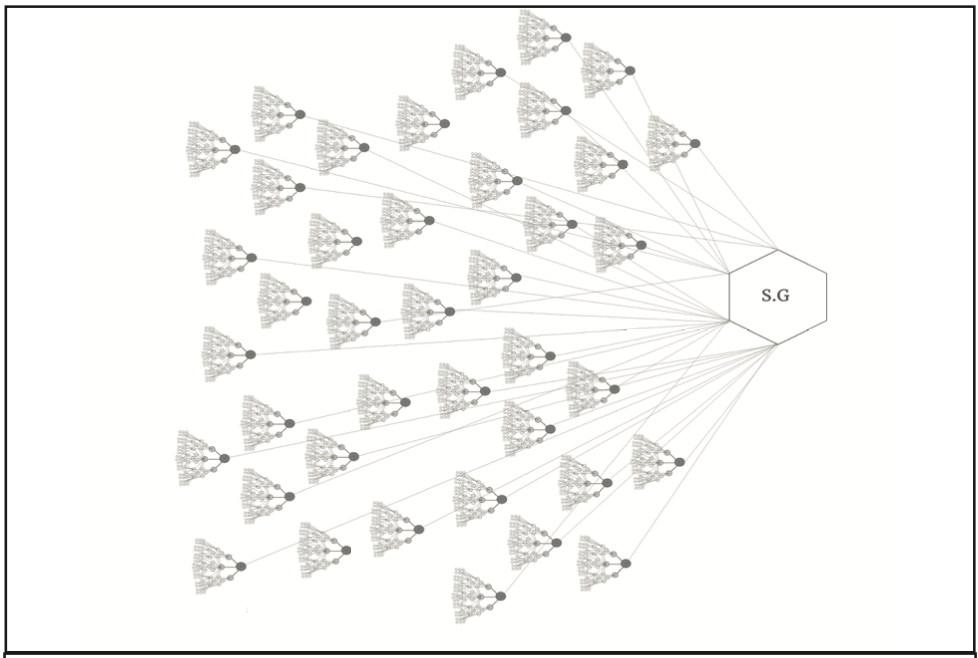
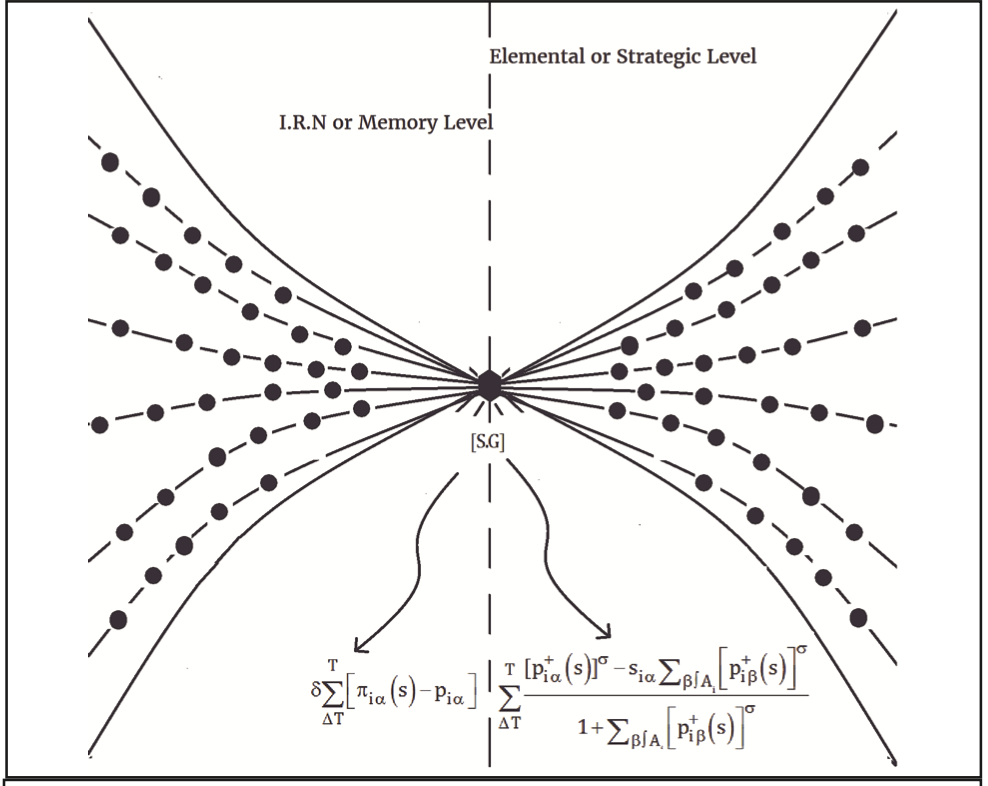
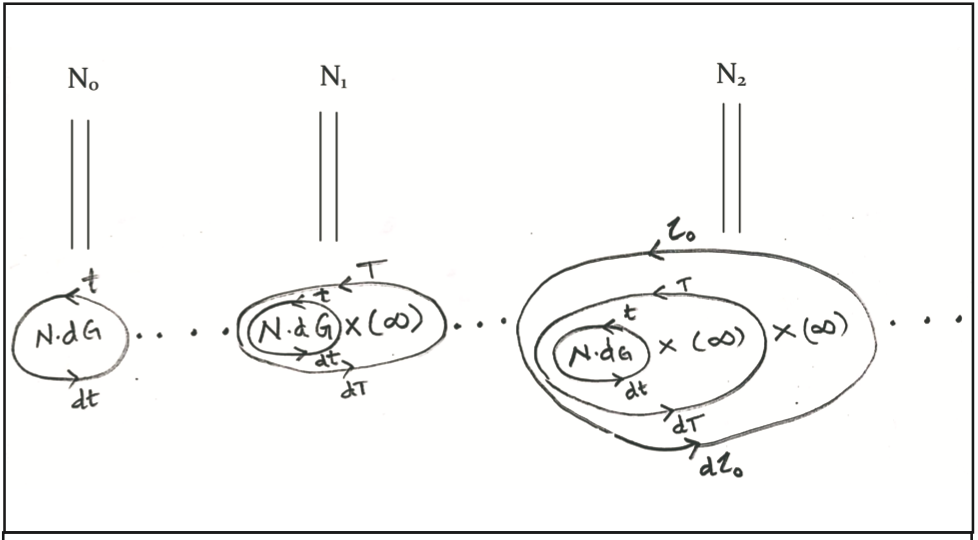
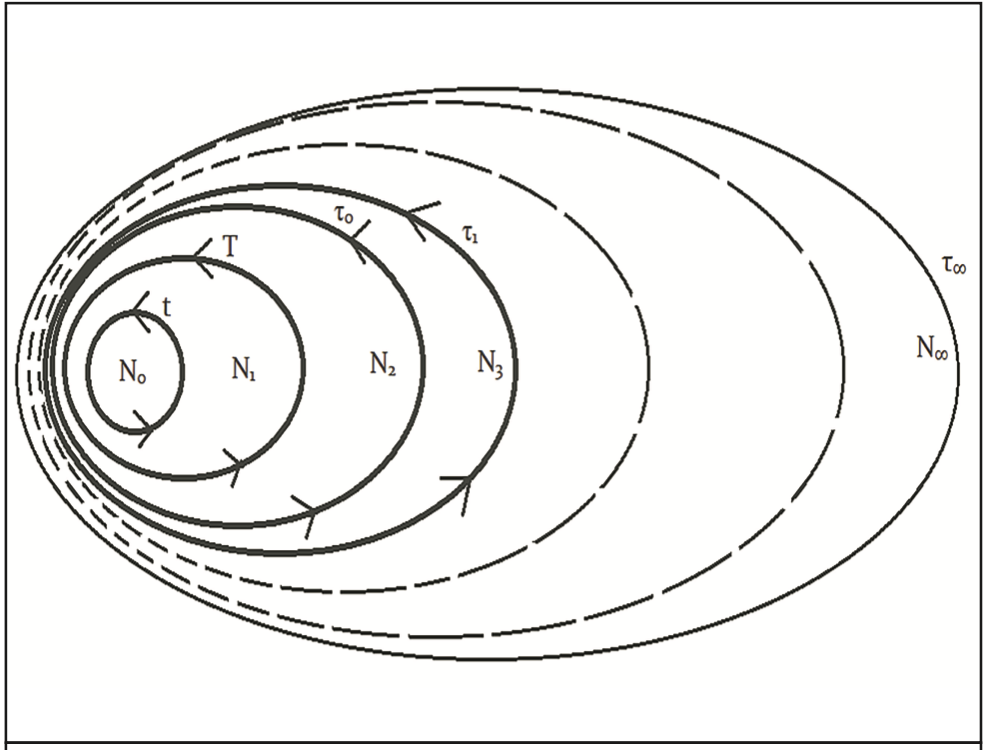
Assertion 1: If the analysis is expanded to infinite I.R.Ns from infinite populations, there must be a single emergence of Nash equilibria at each level of strategic interaction and one ultimate singularity of Nash equilibria with its pole at infinity.This analysis considers thought experiments 14 through 21. For the purpose of analysis, thought experiments 14 through 18 are conceptualized as potential descriptions of interactions at the individual rationality network (IRN) or memory level. Thought experiments 20 and 21 are conceptualized as descriptions of interactions at the elemental or strategic level within the framework of the function S.G or M.M.A.I. Thought experiment 19 serves as a bridging concept between memory-level and strategic-level interactions.
Let all frames, systems, terminal assignments, and markers themselves be represented as mathematical functions in the form of strategies. This implies the neural networks in thought experiments 14 through 18 represent something similar – elemental strategies emerge from within neural mathematical structures at the IRN or memory level of the elements. However, since elemental strategies represent Nash equilibria, inherent cognitive structures of the elements must contain proportional Nash equilibrium functions that mimic or resemble elemental strategic equilibria at an unknown level of proportionality. In the case where a swarm interaction (e.g. G) is considered, all proportional states of Nash equilibria within and between elements must be proportional to the overall growth rate ‘g’ of the swarm in some form.
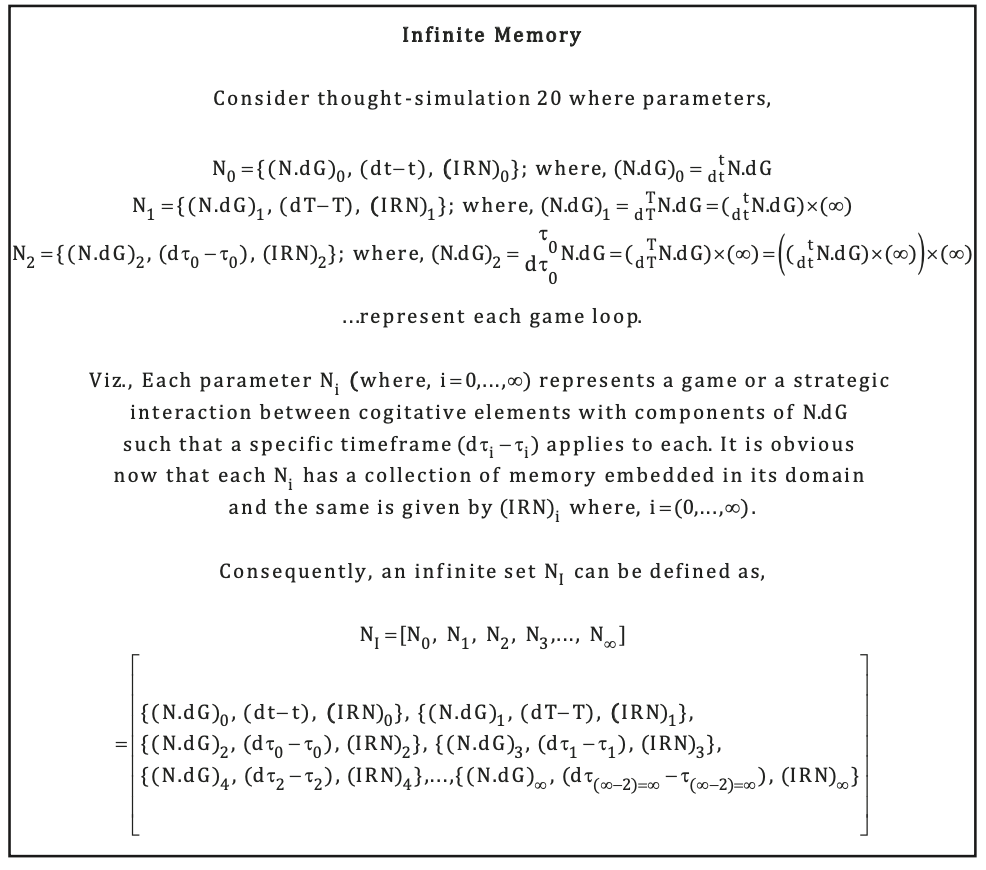
Thought experiments 20 and 21 and the mathematical description of infinite memory are considered in the ongoing context to examine the nature of the singularity. In thought experiment 20, three game loop parameters N0, N1, and N2 are presented, where N0 is a subset of N1, and N1 is a subset of N2. That is, each incremental parameter is a superset of its predecessor. The mathematical analysis of these game loops also incorporates memory in the form of (I.R.N)0, (I.R.N)1, and so on.
N0 and N1 have a direct correlation with S.G or M.M.A.I. Additionally, the memory units (I.R.N)0 and (I.R.N)1 represent perceived payoffs corresponding to pure strategy sets available in the memory of elements within the swarm. It is established that large strategic interactions represented by N0 contain strategic equilibria as Nash equilibria, while interactions represented by N1 contain Nash equilibria as defined by S.G or M.M.A.I.
If it is assumed each parameter (denoting a specific game loop) is a subset of an infinite sequence of ever-larger super game loops, with infinite components from the preceding loop, the process becomes almost continuous, extending to infinity (analogous to infinite series in pure mathematics). This is defined by the function NI = [N0, N1, N2,…N∞].
Recall the first consequential assertion:
“If the analysis is expanded to infinite I.R.Ns from infinite populations, there must be a single emergence of Nash equilibria at each level of strategic interaction and one ultimate singularity of Nash equilibria with its pole at infinity.”
Each parameter Ni contains a box-set of memory represented as (I.R.N)i. Therefore, the set NI defined as [N0, N1, N2,…N∞] would have infinite memory in its domain. It is also true that for each box-set of memory linked to each game loop, there is an emergence of Nash equilibria. If the analysis is expanded to an infinite number of I.R.Ns from infinite populations, there must be a single emergence of Nash equilibria at every level of strategic interaction (each level defined by a different game loop), and one ultimate singularity of all the Nash equilibria with its pole at infinity (see thought experiment 19).
In thought experiment 19, strategic equilibria at the I.R.N or memory level and at the elemental or strategic level are shown coinciding at the singularity, with their strategic domains extending to infinity. If no distinction is drawn between the two interaction styles within and external to the cognitive structures of the elements, a clear graphical representation of the singularity with its pole extending to infinity is expressible in a form analogous to the graphical function y = (1/x).
Assertion 2: If the analysis is stretched over a spatial lattice, as done in (Killingback, T, Doebeli, M, 1996), and later inflated to a 3D-space, the collection of information embedded in the 3D-environment represents a wave. Spatial evolutionary game theory incorporates space into classical evolutionary game theory by distributing evolutionary strategies across spatial regions. This allows the study of how spatial characteristics and localized interactions between neighboring strategy populations affect evolutionary dynamics. Strategies are associated with cells in a spatial lattice or grid to model localized interactions and outcomes. In one approach, strategy populations are confined entirely within individual lattice cells to observe evolutionary interactions between adjacent cells. In another approach, “spatial extensions of evolutionary games” are created by restricting single strategies to occupy individual lattice cells and then defining local update rules for “updating” strategy assignments between cells. These spatial generalizations of games, where cells contain single strategies and follow local update rules, produce complex self-organizing spatial dynamics. This cellular automaton-style representation on a grid of strategy-assigned cells with local interaction rules (finite cellular automaton) is commonly used to define an evolutionary game (Killingback, T, Doebeli, M, 1996).
Classical evolutionary game theory focuses on finding evolutionary stable strategies (ESS) and analyzing strategic equilibrium states. The spatial framework imposes additional constraints by localizing strategies and interactions that fundamentally change the dynamics compared to non-spatial models. Hence, spatial evolutionary game theory exhibits qualitative differences from classical non-spatial evolutionary game theory (Killingback, T, Doebeli, M, 1996).
The Nash equilibrium is identified here as a universally applicable ESS in both spatial and non-spatial contexts. The function S.G derives the set of ESS (Nash equilibria) from an original two-dimensional game G. If this same game G is spatially extended using techniques from spatial evolutionary game theory as described above, the inherent qualitative structure and dynamics of the function S.G and its ESS sets are altered, as explained earlier regarding the fundamental impacts of spatial constraints.
Game G contains an infinite number of component sub-games N.dG, each consisting of the base sub-game dG played repetitively by elements drawn from infinite strategy-diverse populations. Each of these elements may contain n number of strategies in its cognitive domain. Spatial allocation of strategies to locations and definition of local update rules, along with spatial allocation of each iterative sub-game loop N.dG into population cells containing substrates of strategy-allocated cells, extends game G into a spatial representation. Further inflating this two-dimensional spatial structure into a three-dimensional spatial lattice fully extends game G into three-dimensional space. This outlines a general conceptual approach for the spatial extension of game G, while specific implementation details may vary.
Waves are disturbances transmitting energy or information through a space. When information in the form of evolutionary strategies is encoded into three-dimensional cells, and this information travels between cells in the form of propagating “traveling waves” and emergent “stable spatial patterns,” then this collective dynamic three-dimensional spatial information represents a wave phenomenon (Nowak, M.A & Sigmund K, 2004). Thus, when game G is spatially extended into three-dimensional space, the transmission of strategy information and interactions between elements occurs through these traveling waves of encoded strategy information. Stable states of evolutionary stable strategies or equilibria will still emerge in the spatially extended version of game G in the form of Nash equilibria, but conducting analysis on this vastly more complex spatial system is inherently more difficult than in the non-spatial setting. Therefore, purely logical possibilities and paradigms for the behavior of the spatially extended system are suggested here based on strong, peer-reviewed research articles, without attempting to expand the analysis beyond basic conceptual understanding.
Assertion 3: States of Nash equilibria correspond to the hypersensitive points in nature.Refer back to the blogpost on chaos for some of the examples discussed below.
To relate the theory’s foundation to hypersensitive points, it is necessary to define them in terms of their apparent yet unknown natural behavior. One noticeable aspect from their placement in dynamical systems is that hypersensitive points tend to provide choices. In the A-shaped wedge example, the hypersensitive point offers two choices to the ball – slide left or right. If replaced by a smooth cone, the hypersensitivity amplifies to multiple choices coinciding with different tangents or slant heights. This idea of a “provision of choices” is exploitable if understood by intelligent systems.
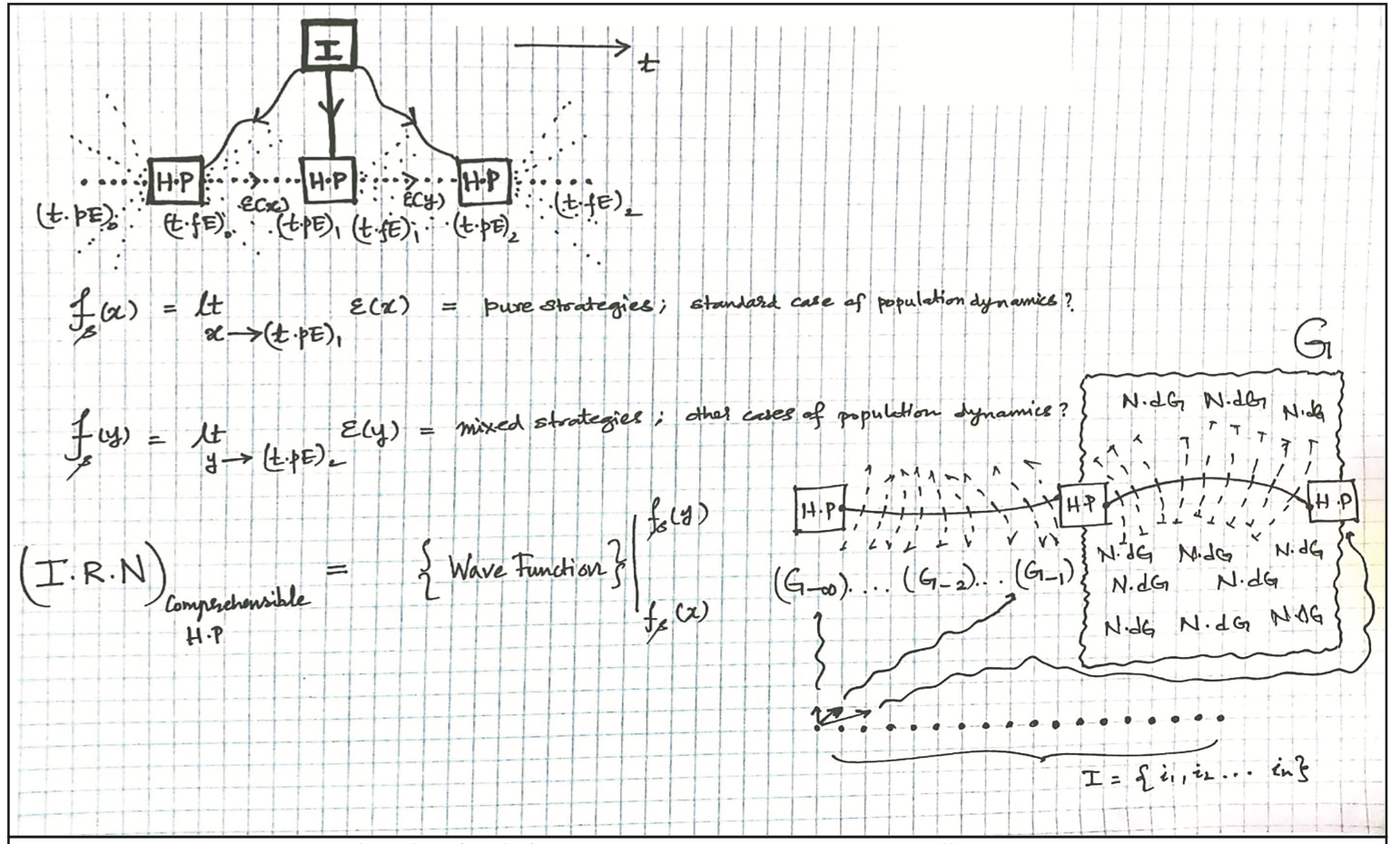
An example in an asteroid context illustrates a potential understanding: The grid image shows a hypersensitive point’s state in space (left portion of the image) from (t.pE)0 to (t.fE)2, where (t.pE)0 is the observable hypersensitive space in the recent past and (t.fE)2 is the future conceivable version. An intelligent unit I observes this space. The functions fs(x) and fs(y) provide a strategic memory continuum – the comprehensible or conceivable I.R.N. Since fs(x) stems from established memory/I.R.N, the strategies for space {(t.pE)0 – (t.fE)0 – (t.pE)1} are known, giving a pure strategic profile. For space {(t.pE)1 – (t.fE)1 – (t.pE)2 – (t.fE)2} the profile must be innovative versus the pure {(t.pE)0 – (t.fE)0 – (t.pE)1} profile. These functions can model a representative wave.
In the bottom image, a group of intelligent units observe the space. Here, game G of strategic adaptation restricts space {(t.pE)1 – (t.fE)1 – (t.pE)2 – (t.fE)2}, including memory, innovation, and perception. G’s memory emerges from {(t.pE)0 – (t.fE)0 – (t.pE)1} and relates proportionally to likely strategy adaptation in G, only possible with ESS/Nash equilibria. This is exploitable in gravitational hypersensitive spaces.
Consider Lagrange points, for example. Lagrange points arise dynamically in the combined gravitational fields between orbiting astronomical bodies like planets, moons, and asteroids. At these sensitive Lagrange points, the gravitational forces of the two bodies precisely balance out, creating areas of stability where spacecraft can orbit while expending minimal fuel for station-keeping. The five well-known Lagrange points in the Earth-Sun system have been exploited heavily to position satellites and space telescopes in scientifically useful orbits. Likewise, the stability of Lagrange points in asteroid systems can be leveraged by future spacecraft and missions, including hypothetical intelligent swarms that may someday traverse the cosmos. If such an intelligent swarm can comprehend the complex gravitational dynamics that generate hypersensitive Lagrange points, and can partially predict the trajectory of a given Lagrange point over time, then innovation and invention within the swarm could provide the required behavioral strategies and adaptations to handle the conceivable path ahead. This example illustrates the potential value of understanding hypersensitive phenomena to intelligent systems.
The pendulum over magnets demonstrates sensitive mixed-influence spaces. Similarly, dual/collective magnetic influence regions approximate potential hypersensitive spaces. Lagrange points’ dynamic stability/hypersensitivity have enabled space missions – asteroid system Lagrange points are exploitable by intelligent swarms. If a hypersensitive trajectory is partially understood, innovation/invention can supply the strategic amalgamation to handle the conceivable path, as previewed in Thought Simulation 23. In summary, hypersensitive points’ unknown natural provision of choices is exploitable if understood by intelligent systems, as illustrated in an asteroid example. Functions model strategic memory and innovation across time points of a hypersensitive space observed by intelligent units. The related game restricts the future space with memory, innovation and perception, only adaptable with Nash equilibria. This exploitability applies to gravitational hypersensitivity like Lagrange points. With partial trajectory understanding, innovation can provide strategies to handle conceivable paths.
Of the three consequential assertions made, the first one has been logically reasoned completely, while the second and third are demonstrated using simulated paradigms. Therefore, significantly more research is still required in these areas. The next blogpost advances the current research a bit further in explaining the very nature of reality itself and the role of consciousness within it.
References
[1] Griffin, M, Ono, K & Rolen, L, ‘Ramanujan’s Mock Theta Functions’, Department of Mathematics and Computer Science – Emory University, Atlanta, GA 30322
[2] Folsom, A 2010, ‘a Mock Modular Form?’, Notices of the AMS, Vol 57. No.11
[3] Killingback, T, Doebeli, M. (1996). Spatial Evolutionary Game Theory: Hawks and Doves revisited. Proceedings: Biological Sciences, 263, pp. 1135-1144.
[4] Nowak, M.A & Sigmund K. (2004). Evolutionary Dynamics of Biological Games. SCIENCE, 303, 793-798.
